
I’m confused. I’ve got Mazda engineers in one ear, including MPS project chief Joe Bakaj, whispering about the drifting abilities of the new Mazda6 MPS. I’ve got marketing bods telling me the new MPS is sophisticated and not in the same gene pool as rally weapons from Subaru and Mitsubishi.
This feature was originally published in MOTOR’s February 2005 issue
Then there’s talk that this all-paw, turbocharged sports sedan is a real driver’s car and will even allow you to pull handbrake turns. But the design team went to great pains to style a subtle car, even hiding the air scoops for the top-mounted air-to-air intercooler within a false bonnet, so the bodywork would not be punctured by ugly vents or scoops.
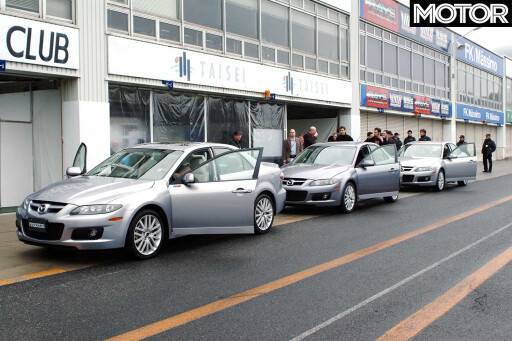 And yet, here I am about to get my first taste of the MPS at a race track… Confused? Me too.
And yet, here I am about to get my first taste of the MPS at a race track… Confused? Me too.
The Mazda6 MPS is not a bold new direction, but rather a continuance of what Mazda started three years ago with the regular 6. Since then, the once wayward company has revamped its product line-up with cars like the 2, 3 and of course, the rotary-powered RX-8.
And later this year, Mazda will add the new generation MX-5 to the forecourt. Plus there’s talk of a new RX-7 and a hotter version of the RX-8.
But the 6 MPS is Mazda’s current performance king and the fastest sedan ever produced by the company with performance boasts of 0-100km/h in 6.4-seconds and a top speed around 250km/h.

It’s easy to think of the engine as a stock motor with a turbo flung onto the side. But it ain’t so simple. The 2.3-litre block remains, but nearly every other part has been breathed on in the transformation to forced-induction. There’s a new cylinder head and forged pistons with a drop in compression ratio from 10.6:1 down to 9.5:1. Then there’s the Hitachi turbo and intercooler.
The MPS engine is also the world’s first direct injection turbocharged petrol engine, just beating VW’s effort to market. And it’s the combined effects of direct injection and the reasonably high static compression ratio, that gives the MPS excellent throttle response and all-but banishes turbo lag.
In fact, it’s so linear, you’re left wondering if there really is 190kW at 5500rpm. But there’s no doubting the 380Nm at 3000rpm.
Drive is taken off the gearbox via a water-cooled coupling, and a propshaft feeds up to 50 percent of the available torque to the rear wheels.
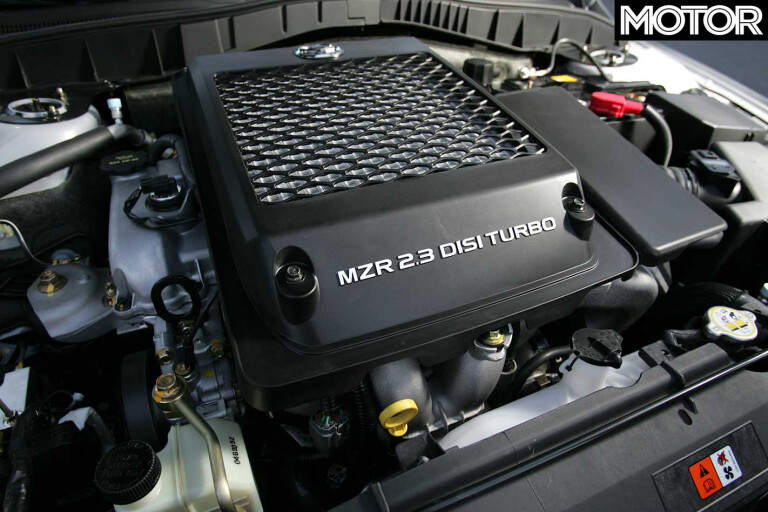
At first glance the MPS looks little different from a top spec Mazda6 (which it now is). On my second lap of the car, however, I notice the bulging bonnet, which is 45mm taller to accommodate the top-mounted intercooler. Lift the bonnet and there’s twin scoops – similar to the fake nostrils on the outside of a Monaro’s bonnet – feeding air to the intercooler.
Under the subtle skin, there’s additional bracing and welded-in plates, helping improve torsional rigidity by 50 percent over the standard Mazda6. The MPS is only available in sedan form, as it was the stiffest of the 6’s three body styles.
But all this extra bracing and the all-wheel drive hardware pushes the mid-sizer to a seriously fat 1650kg. That’s heavier than a Commodore, and about 200kg tubbier than a Subaru Liberty GT.

The track is still wet from the morning rain, with standing water just off the racing line – an ideal test for the all-wheel-drive grip. Out of pit lane, we join the main straight only a few hundred metres before the tight right at turn one.
Then it’s a short squirt through second and into third gear, before the circuit’s trickiest part; a tightening radius left, leading into a fourth gear left, right change of direction. The MPS turns in well offering reasonably sharp feedback through the wheel – it’s essentially the standard rack with a higher viscosity oil in the pump.
On the wet track, understeer is only present on turn-in if you misjudge your entry speed or throw too much steering angle at the MPS. But it can build if you’re too quick or eager on the throttle or if the corner goes on for a bit.
It needs to be pointed out that these are not production fresh cars, but hard-worn test mules and we’re not the first group of journos to have pounded them around the track. So some of this push is obviously down to the worn 215/45 R18 Bridgestone Potenzas.
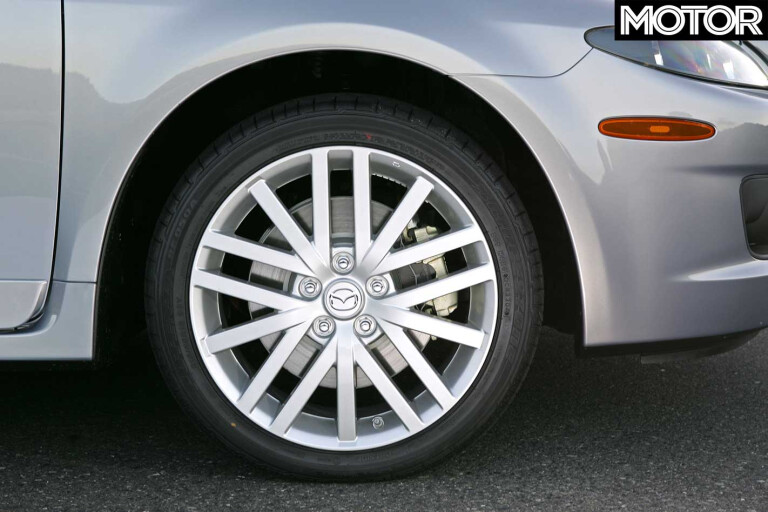
The change of direction spits you out on the correct line for the uphill right. On the first lap I pick the second of six available gears in the light-shifting gearbox, only to have the tacho plunge into the red before the exit. Next time round, I grab third and let the torque of the engine pull the 6 up the hill and onto the back straight.
The engine does its best work in the mid-range, punching hard from around 2000rpm but it gets breathless from six grand. There’s bugger all turbo lag, but there’s also a lack of engine or exhaust note, and there’s no sudden kick in the slats. But it’s a tough call to mark down a turbo engine for not being peaky.
About two-thirds of the way down the back straight, our hosts have set up a witches hat chicane in an attempt to rein in our speed on the approach to a downhill second gear hairpin. Of course, the Aussie contingent of journos just sees this as another challenge, and the chicane is taken flat in fourth at about 170km/h, much to the dismay of the track official stationed at the adjacent marshal’s post.
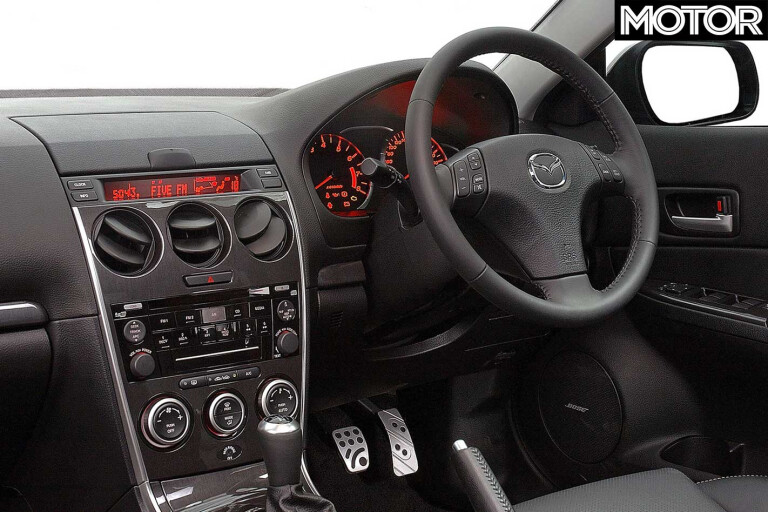
Once the Mazda is straight and settled on its springs – the front is 25 percent stiffer while the rear is a full 33 percent firmer – the brakes are squeezed hard for the hairpin. And it’s here, by lap two of our allotted three, that the brakes start to protest.
There’s a shudder through the steering wheel and a howl from the front right rotor. The brakes (sizeable rotors measuring 320mm front and 314mm rear) still stop, but the pedal gets longer and more lifeless with each big application.
The much talked about oversteer is only brought on through provocation. A combination of favourable camber, a sharp lift of the throttle, or a quick tug of the handbrake will get the tail into play. Once the bum is out, there’s just enough power to keep it out there for few seconds.
This ability to oversteer (however mild) is brought on by the torque split. Though a nominally even split front to rear, the front diff is open while the rear is an LSD, meaning more than 50 percent of available drive can be fed to the rear wellies.

The second session is on a drying track, and while the speed is a bit sharper, the extra grip actually reveals more understeer as the tortured rubber struggles with turn-in. And the higher speeds bring bigger stops and stress the brakes that little bit more.
Final dynamic assessment will need to wait until we get the MPS on Aussie roads – it’s due mid-year at an expected $55,000. Away from the harsh glare of a race track, the Mazda6 MPS should make a very fast and accomplished road car. The understeer and brake dramas highlighted at the racetrack will be very difficult to replicate in road driving. Just don’t expect it to be an Evo or STi fighter.
Our Backsides Trackside
Playing Schumacher at TI Aida Grand Prix circuit
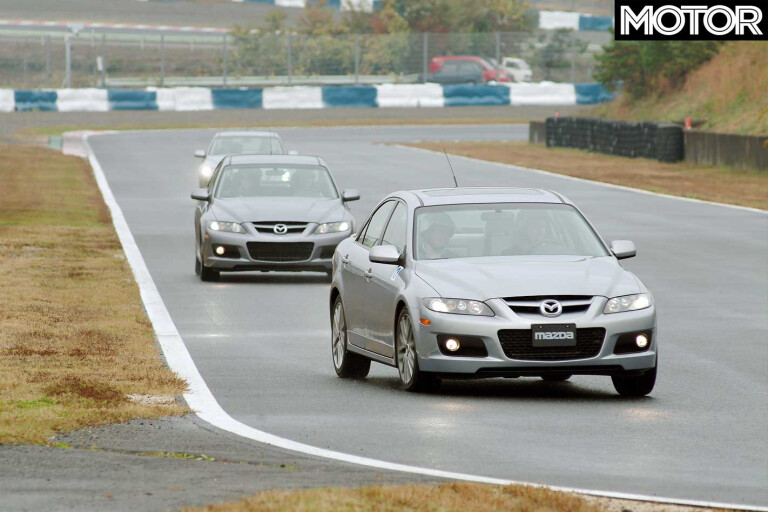
The track we’ve been let loose on is the Tanaka International Circuit at Aida. Built in 1990 and active as a track from 1992, TI Aida played host to two Grands Prix (the Pacific Grand Prix in both 1994 & 1995), as the Japanese Grand Prix was held at Suzuka.
Michael Schumacher was victorious on both occasions in his Benetton on his way to his first two World Driver’s Championships. Schumacher holds the official lap record (set in 1994) with a time of 1:14.023 seconds at an average speed of 180km/h.
The qualifying record is held by Aryton Senna with a time of 1:10.21 seconds. In fact, the 1994 Pacific Grand Prix was Senna’s last race before his fatal accident at Imola just two weeks later.
Unfortunately, the remote location of the circuit caused major inconvenience for teams and spectators with huge delays on the one access road. The experiment ended after just two races, and the track is now used for various club and domestic races.
Driving around TI Aida in an all-wheel drive road car throws the lack of run off areas into sharp focus, so imagine the challenge of threading an 800hp Formula One car through here.

FAST FACTS
2005 Mazda6 MPS
DRIVE: all-wheel
ENGINE: front-mounted, 2.3-litre, 16-valve, turbo four
BORE/STROKE: 87.5mm x 94.0mm
COMPRESSION RATIO: 9.5:1
POWER: 190kW @ 5500rpm
TORQUE: 380Nm @ 3000rpm
WEIGHT: 1650kg
POWER-TO-WEIGHT: 115kW/tonne
TRANSMISSION: 6-speed manual
SUSPENSION: double wishbones, coil springs, anti-roll bar (f); multi-link, coil springs, anti-roll bar (r)
L/W/H: 4670/1780/1430mm
WHEELBASE: 2675mm
TRACK: 1540mm (f); 1540mm (r)
BRAKES: 320mm ventilated discs, single-piston calipers (f); 314mm ventilated discs, single-piston calipers (r), ABS
WHEELS: 18 x 7.0-inch, alloy (f/r)
TYRES: Bridgestone Potenza; 215/45 ZR18 (f/r)
FUEL: 64 litres, PULP
PRICE: $55,000 (est)

COMMENTS